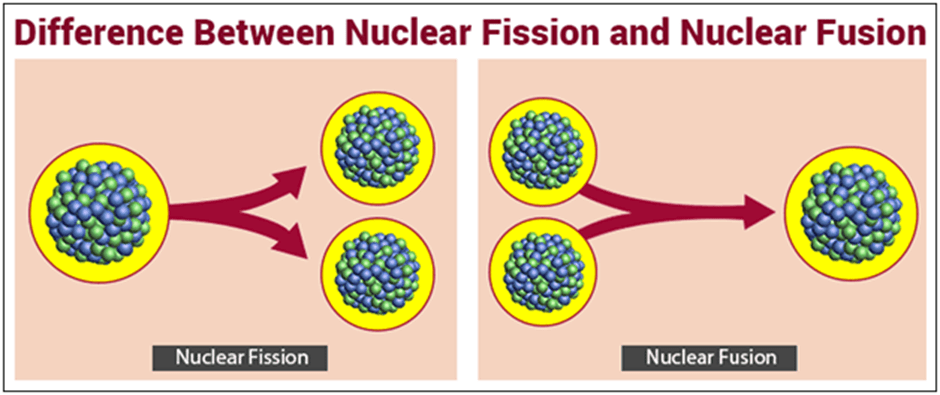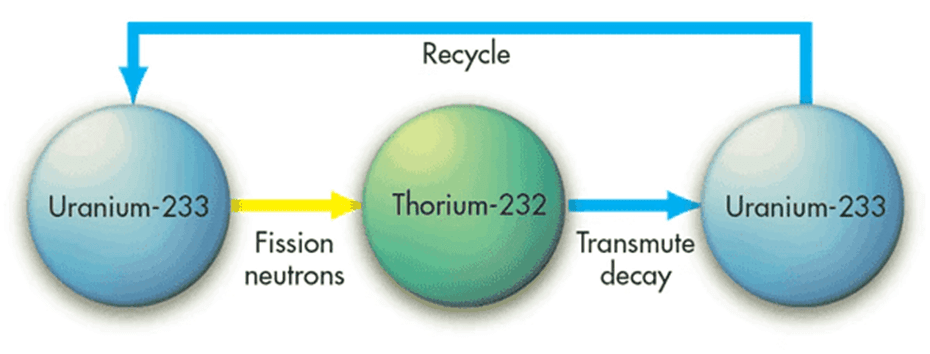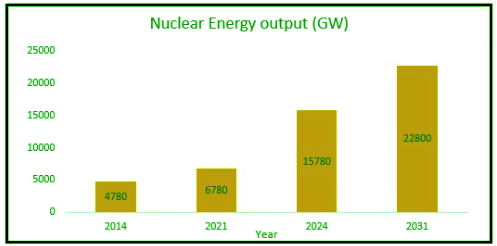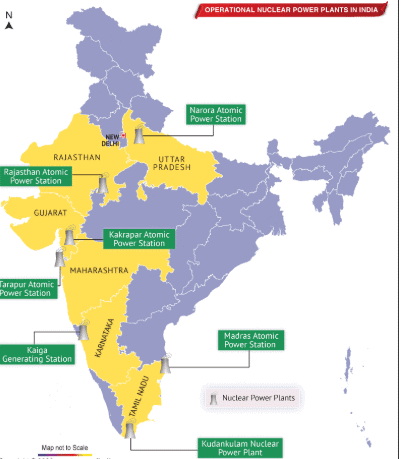Nuclear Energy in India | Science & Technology for UPSC CSE PDF Download
Fissile and Fertile Materials
Fissile material is one that can sustain a chain reaction upon bombardment by neutrons.Fertile material can transmute into a fissile radioisotope (e.g., U-233) but cannot itself sustain a chain reaction.
Thorium is by itself fertile.
In a thorium reactor, a fissile material like uranium or plutonium is blanketed by thorium.
The fissile material, also called a driver, drives the chain reaction to produce energy while simultaneously transmuting the fertile material into fissile material.
1. Nuclear Fission:
- The nucleus of an atom splits into two daughter nuclei.
- This decay can be natural spontaneous splitting by radioactive decay or simulated in a lab by achieving necessary conditions (bombarding with neutrons, alpha particles, etc.).
- The resulting fragments have a combined mass less than the original. The missing mass is converted into nuclear energy.
- Currently, all commercial nuclear reactors are based on nuclear fission.
2. Nuclear Fusion:
- Nuclear Fusion is the combining of two lighter nuclei into a heavier one.
- Such reactions are the source of energy in the Sun and other stars.
- It requires extreme conditions—millions of degrees of temperature and millions of pascals of pressure—to force nuclei to fuse.
- The hydrogen bomb is based on thermonuclear fusion, with a fission-based nuclear bomb (uranium or plutonium) at its core to provide initial energy.

3. Criticality:
- Criticality is the first step towards power production. A nuclear reactor is critical when the nuclear fuel sustains a fission chain reaction.
- Each fission reaction releases a sufficient number of neutrons to sustain a series of reactions. Heat is produced, used to generate steam that spins a turbineto create electricity.
- Fission splits the nucleus of an atom into two or more smaller nuclei and byproducts.
- The kinetic energy of the fission fragments is transferred as heat energy, eventually used to produce steam to drive turbines.
Isotopes
Atoms consist of protons, neutrons, and electrons. The nucleus contains protons and neutrons, with electrons surrounding it. The atomic mass is the sum of protons and neutrons.
Isotopes are atoms with the same number of protons but different numbers of neutrons. Thus, isotopes have the same atomic number but different mass numbers.
For example: U-233, U-235, U-238 (U – Uranium).
Of these, U-233 and U-235 are fissile, while U-238 is fertile.
The first two break down to produce heat, neutrons, and two lighter nuclei, while U-238 transmutes into Pu-239, a fissile substance.
Similarly, Th-232 is fertile and transmutes into U-233.
India’s Nuclear-Weapons Journey
India embarked on nuclear weapons development after the 1962 war with China, followed by China’s nuclear tests in 1964 and subsequent years.
- In 1974, under Prime Minister Indira Gandhi, India conducted Pokhran-I, dubbed a “peaceful nuclear explosion.”
- Despite international pressure, India conducted Pokhran-II in May 1998, testing a fission device, a low-yield device, and a thermonuclear device, enabling nuclear warheads for its missile program.
- Two weeks later, Pakistan conducted similar tests, confirming its nuclear weapons program, which has since expanded rapidly.
In 1999, India adopted a nuclear doctrine emphasizing “No First Use” (NFU), minimal deterrence, and non-use against non-nuclear-weapon states, as articulated by former National Security Adviser Shivshankar Menon. The NFU, paired with credible minimum deterrence (CMD), remains a cornerstone of India’s nuclear policy.
Nuclear Energy in India
As of 2025, India’s nuclear power plants contribute approximately 3.5% to the national energy mix, a modest increase from 3% in 2020, driven by new reactor commissions. The Indo-US Nuclear Deal (2008) facilitated international cooperation, enabling the commissioning of Kudankulam Units 1–3 (with Russian assistance) and progress on Units 4–6, expected by 2027.
Nuclear Fuel of the Future: Thorium
According to the Atomic Minerals Directorate for Exploration and Research (AMD), India has 11.93 million tonnes of monazite, containing about 1.07 million tonnes of thorium, representing 25% of global reserves. Thorium can reduce uranium imports, enhancing energy security.
- U-233 produced from thorium releases eight times the energy per unit mass compared to natural uranium.
- Thorium dioxide is more stable than uranium dioxide, reducing waste management challenges.
- Higher thermal conductivity allows heat to dissipate quickly, reducing meltdown risks.
- Thorium’s melting point is 500°C higher, enhancing safety during accidents.
Thorium Cycle – Working
Thorium-232 is a fertile material. The thorium cycle is depicted in the following figure:
Reasons Thorium Has Not Been Fully Developed
- Producing U-233 from thorium requires reactors fueled by uranium-235, which are limited in India.
- Large-scale reprocessing of irradiated thorium poses technical challenges.
- Thorium cannot be weaponized, unlike uranium, which historically drove nuclear energy development globally.
Spent Fuel Reprocessing Process
- Spent fuel contains increased non-fissile material and byproducts, rendering it unusable in its current form.
- An open fuel cycle discards spent fuel, while a closed cycle reprocesses it for reuse.
- India’s program maximizes uranium and thorium utilization through a closed fuel cycle.
- Global uranium scarcity necessitates closed fuel cycles for sustainable nuclear power expansion.
Uranium Enrichment
Uranium enrichment increases the percentage of U-235 using centrifuges. Natural uranium comprises 99.3% U-238 (non-fissile) and 0.7% U-235 (fissile). Enrichment enhances U-235 content for reactor fuel.
Enriched uranium is categorized as:
- Low Enriched Uranium (LEU): U-235 ≤ 20%, used for peaceful purposes (e.g., Jaitapur requires 5% LEU).
- High Enriched Uranium (HEU): U-235 > 90%, weapon-grade, restricted for nuclear tests and weapons.
Nuclear Cooperation Agreement
India aims to produce 25% of its electricity from nuclear sources by 2050, with interim targets of 13,800 MW by 2032 and 100,000 MW by 2047, aligning with net-zero goals by 2070. As of 2025, nuclear capacity is 8,900 MW, contributing 3.5% to total electricity. Domestic uranium meets only 20% of demand, necessitating imports.
India has nuclear cooperation agreements with Argentina, Australia, Canada, France, Japan, Kazakhstan, Mongolia, Namibia, South Korea, Russia, UK, USA, and Uzbekistan, providing:
- Nuclear fuel.
- Nuclear reactors.
- Enrichment and reprocessing (ENR) technology, contingent on NSG membership.
India’s obligations include a separation plan and IAEA safeguards. In 2006, of 21 reactors, 14 were classified as civilian (under IAEA inspection) and 8 as military, recognizing India’s nuclear weapons status. India negotiated a unique Additional Protocol, committing to:
- Inspecting 14 civilian reactors.
- Notifying IAEA of uranium exports to non-nuclear states.
- Notifying IAEA of thorium exports to non-nuclear states.
Nuclear Diplomacy and India: Controversies and Relations
India maintains a voluntary moratorium on nuclear testing and is developing a Nuclear Liability Law to define accident liabilities, addressing concerns post-Fukushima (2011).
Indo-US Nuclear Deal
Under Prime Minister Manmohan Singh, India signed the Indo-US Nuclear Deal, known as the 123 Agreement, under Section 123 of the US Atomic Energy Act 1954. The Hyde Act (2006) amended NPT requirements, enabling the deal’s ratification in 2008.
- Public protests and political opposition limited progress, but capacity grew from 6,780 MW in 2020 to 8,900 MW in 2025.
- In 2021, India announced tripling nuclear capacity by 2031, targeting 13,800 MW, with a long-term goal of 100,000 MW by 2047.
Highlights of the agreement:
- The US supplies nuclear fuel, maintaining a one-year strategic reserve for civilian reactors, or arranges alternative suppliers.
- The US provides reactors (e.g., six for Kovvada, Andhra Pradesh).
- Reprocessing of spent fuel is permitted in a centralized IAEA-safeguarded facility for 14 civilian reactors.
India rejected linking the deal’s termination to nuclear testing. If India tests, negotiations occur within a year, with termination requiring one-year notice. The deal is reviewed annually by the US President.
Implications:
- Ended India’s nuclear isolation.
- Provided access to advanced nuclear technology for energy security.
- Recognized India as a nuclear-weapon state.
- Preserved India’s right to conduct nuclear tests.
- De-hyphenated India-Pakistan in US policy.
Indo-Japan Nuclear Deal
Finalized in November 2016, India is the only non-NPT country with a nuclear cooperation agreement with Japan. The deal is significant because:
- Japan, with China and Russia, monopolizes steel for reactor cores.
- French (Areva) and US (General Electric, Westinghouse) suppliers, controlled by Japanese firms (Mitsubishi, Hitachi, Toshiba), require Japan’s consent.
Post-Fukushima (2011), talks paused but resumed with India proposing reactor purchases over steel. The agreement includes:
1. Notes on Views and Understanding: India commits to No First Use and voluntary nuclear testing restrictions.
2. Main Agreement: India views only this as binding, rejecting Japan’s attempt to link nuclear tests to deal termination.
Given geopolitical dynamics, Japan is unlikely to undermine India, especially with shared concerns about China. The deal enables joint ventures for reactor construction, facilitating technology transfer and India’s NSG membership prospects.
India’s Three-Stage Nuclear Power Programme
Formulated in the 1950s by Dr. Homi Bhabha, this program leverages uranium and thorium reserves in monazite sands, especially in Kerala, for long-term energy independence, culminating in the Thorium Fuel Cycle.
In 1954, Asia’s first research reactor, APSARA, was installed, followed by CIRUS (Canada), Dhruva (indigenous, largest plutonium supplier for weapons), and BARC’s ZERLINA and PURNIMA I-II-III. Only DHRUVA operates today.
The Indira Gandhi Centre for Atomic Research developed Kamini, Fast Breeder Test Reactor, and the Prototype Fast Breeder Reactor (PFBR), which achieved criticality in July 2024, marking a milestone in Stage 2.
The program includes:
- Pressurized Heavy Water Reactor (PHWR).
- Fast Breeder Reactor (FBR).
- Advanced Heavy Water Reactor (AHWR).
Stage 1 (PHWR)
- Uses natural uranium to fuel PHWRs, producing electricity and plutonium-239 as a by-product.
- PHWRs were chosen in the 1960s for efficient uranium utilization.
- Heavy water production was prioritized over uranium enrichment facilities.
- PHWRs use unenriched uranium, unlike Light Water Reactors (LWRs), and components are domestically produced.
- Plutonium-239 is used in Stage 2.
First Stage: Reactor Types
- Boiling Water Reactor (BWR).
- Pressurized Heavy Water Reactor (PHWR).
- Pressurized Water Reactor (PWR).
BWR
- In 1962, India acquired two BWRs from the USA, installed at Tarapur.
- Uses light water as moderator and coolant.
- Requires enriched uranium as fuel.
PHWR
- Also known as CANDU (Canadian Deuterium Uranium).
- Uses heavy water as moderator and coolant.
- Uses natural uranium as fuel.
- Constitutes the majority of India’s operational reactors.
PWR
- Light Water Reactor (LWR).
- Uses light water as moderator and coolant.
- Requires enriched uranium as fuel.
- Incorporates advanced safety mechanisms (Generation III+).
India operates PWRs from Russia (VVER: Voda Voda Energy Reactor) and is negotiating with France for the Jaitapur EPR project (6x1650 MW).
Stage 2 (FBR)
- Uses plutonium-239 in mixed-oxide fuel for Fast Breeder Reactors. Plutonium-239 undergoes fission, and metal oxide reacts with enriched uranium to produce more plutonium-239.
- Thorium is introduced to produce U-233 for Stage 3.
- The PFBR (500 MW) at Kalpakkam achieved criticality in July 2024, with plans for two additional FBRs by 2030.
Second Stage: Reactor Type
Fast Breeder Reactor
- First at Kalpakkam, Tamil Nadu.
- Uses Pu-239 as fuel, converting U-238 into Pu-239.
- Also known as Fast Neutron Reactor.
- No moderator; uses liquid sodium as coolant.
Stage 3 (AHWR)
- Aims for a sustainable nuclear fuel cycle using U-233 and thorium in thermal breeder reactors.
- Thorium’s challenges (requiring fissile material like U-233 or plutonium) delayed its use until Stage 3.
- Thorium absorbs neutrons efficiently, producing plutonium in FBRs for faster growth.
- Large-scale thorium deployment awaits sufficient U-233 production, supported by the 2025 Nuclear Energy Mission’s Rs. 20,000 crore investment.
AHWR: Advanced Heavy Water Reactor
- Uses U-233, produced from thorium, as fuel.
- Employs light water as coolant and heavy water as moderator.
- Under development by BARC, with pilot projects planned by 2030.
Nuclear Weapon Programme
Following CIRUS, the indigenous Dhruva reactor was developed to supply plutonium for weapons. Operation Smiling Buddha (May 1974) was India’s first nuclear test, described as a peaceful explosion. All devices were fission-based and sub-kiloton.
The Nuclear Suppliers Group (NSG), initially the London Club, emerged to control nuclear technology transfers, requiring NPT signature and IAEA safeguards. NSG membership requires:
- Technology export capability.
- Compliance with NSG guidelines.
- Contribution to non-proliferation.
- Domestic anti-proliferation measures.
- NPT or nuclear-weapon-free zone treaty signature (e.g., Bangkok, Pelindaba, Tlatelolco, Rarotonga, Semipalatinsk).
In 2008, External Affairs Minister Pranab Mukherjee addressed the NSG, committing to No First Use and a testing moratorium. The US secured a special waiver, allowing India to receive nuclear technology without NPT compliance.
The Highlights of Doctrine
1. No First Use
Three schools of thought—Pragmatism (favoring NFU), Maximalism (first use), and Rejectionism—debated the doctrine. Pragmatism prevailed, adopting NFU: India will not initiate nuclear use but will retaliate massively if attacked.
This requires a second-strike capability, achieved with the nuclear triad (Army, Navy, Air Force). INS Arihant, with Sagarika missiles, completed the triad, but 4–5 submarines are needed for credibility, under negotiation with Russia and France.
A 2003 modification allows nuclear retaliation against biological or chemical attacks, regardless of the attacker’s nuclear status, acting as a deterrent.
Debates persist on shifting to first use, driven by:
- Improved technology since 2003.
- China’s conventional military advantage.
- Pakistan’s state-sponsored terrorism.
Advantages of No First Use:
- Minimizes nuclear war risk if both parties adopt NFU.
- Reduces political pressure on leadership.
- Avoids arms races, unlike first-use policies.
- Supported NSG waiver and nuclear deals; changing it risks international backlash.
- India commits to non-use against non-nuclear states and a testing moratorium.
- The Nuclear Command Authority, led by the Prime Minister, oversees decisions, with execution by the Strategic Forces Command.
Credible Minimum Deterrence
India maintains a minimum number of nuclear weapons to inflict unacceptable damage, tailored to adversaries’ societal, economic, and defense structures.
International Atomic Energy Agency
About:
- The IAEA, known as the “Atoms for Peace and Development” organization, is the global center for nuclear cooperation within the UN.
Establishment:
- Created in 1957 to address nuclear technology’s potential and risks.
Headquarter: Vienna, Austria.
Objective:
- Promotes safe, secure, and peaceful nuclear technology use.
- Awarded the Nobel Peace Prize in 2005 for its safety and peace efforts.
Nuclear Power Corporation of India Limited
- NPCIL, headquartered in Mumbai, is a public sector undertaking wholly owned by the Government of India.
- Responsible for generating nuclear power for electricity, administered by the Department of Atomic Energy (DAE).
- As of 2025, 23 reactors with a capacity of 8,900 MW operate at over 80% plant load factor.
- Includes 18 Pressurized Heavy Water Reactors (PHWRs) and 5 Light Water Reactors (LWRs, including Kudankulam’s VVERs).

The Stockholm International Peace Research Institute (SIPRI)
- SIPRI, established in 1966 in Stockholm, researches conflict, armaments, arms control, and disarmament.
- Provides data and recommendations to policymakers, researchers, and the public.
The Treaty on the Non-Proliferation of Nuclear Weapons (NPT)
- The NPT aims to prevent nuclear weapons proliferation, promote peaceful nuclear energy, and achieve disarmament.
- Opened for signature in 1968, effective 1970, with 191 states, including five nuclear-weapon states.
Status of Nuclear Energy in India
- India, a developing nation, generates electricity using indigenously developed nuclear reactors.
- Nuclear energy is the fifth-largest electricity source.
- India ranks third globally in electricity production, generating 1,207 TWh.
- India is seventh worldwide in nuclear reactor count.
- As of 2025, 23 reactors in 7 power plants produce 8,900 MW.
- India aims to increase nuclear energy’s share from 3.5% to 5% by 2032, targeting 13,800 MW.

Operational Nuclear Power Plants in India:

Way Forward
Utilizing Available Resources: India has 70,000 tonnes of uranium and 360,000 tonnes of thorium. With uranium imports being costly and geopolitically sensitive, the 2025 Nuclear Energy Mission (Rs. 20,000 crore) prioritizes thorium-to-U-233 conversion and Small Modular Reactors (SMRs, 50–300 MW) for remote and industrial use.
Domestic uranium production has increased with new mines in Andhra Pradesh and Jharkhand, reducing import dependency.
- Addressing Pre-Project Issues: Streamline land acquisition, environmental clearances, and foreign collaborations. Private sector involvement, enabled by 2025 Atomic Energy Act amendments, allows up to 49% foreign investment in SMRs, reducing capital costs.
- Addressing Safety Concerns: Post-Fukushima safety upgrades include Generation III+ designs and stress tests. Deep geological repositories at Kalpakkam and vitrification of high-level waste enhance waste management. The Nuclear Safety Regulatory Authority, proposed in 2025, will ensure compliance with IAEA standards.
- Technological Support: Boost reprocessing and enrichment with advanced technology. SMRs and Thorium-based reactors, supported by the 2025 Budget, aim to meet the 100 GW target by 2047, integrating with renewables for net-zero by 2070.
Public Engagement and Legal Reforms: Address public opposition (e.g., Jaitapur protests) through transparent safety communication. Planned amendments to liability laws will facilitate private investment while ensuring national security.
Recent Developments
1.
Prototype Fast Breeder Reactor (PFBR) at Kalpakkam
Progress & Delays: The PFBR has entered its integrated commissioning phase following core loading in March 2024, with AERB approval granted in July 2024. Criticality was anticipated by March 2026, with full commissioning expected by September 2026. However, first-of-a-kind technical challenges have emerged, causing further delays. Authorities note that “these issues are being solved systematically.”
Why It Matters: As a key component of India’s three-stage nuclear programme, PFBR's activation is crucial for transitioning to Stage III (thorium-U³³ cycle), making these delays significant.
2.
Small Modular Reactors (SMRs) - India’s Nuclear Mission
Budgetary Backing: The 2025–26 Union Budget announced a ₹20,000 crore commitment (~US $2.4 billion) under the Nuclear Energy Mission for Viksit Bharat, targeting the design and deployment of at least five indigenously developed SMRs by 2033. Legislative reforms are underway to enable private sector and foreign participation.
International Partnerships:
In early 2025, India and France signed a declaration of intent for collaboration on advanced and small modular nuclear reactors.
The US Government (DoE) has authorised Holtec International under regulation 10CFR810 to transfer its SMR-300 technology to Indian partners (L&T, Tata Consulting Engineers, and Holtec Asia), a significant step toward technology sharing.
Industry Push: NTPC, India's largest power producer, has initiated feasibility studies and issued a tender to explore deploying SMRs to replace aging coal-fired plants—an early private-sector move into nuclear energy.
3.
Nuclear Capacity Expansion
PHWR Fleet Expansion: NPCIL is preparing to seek approval for constructing 10 new PHWRs (each 700 MW) in “fleet mode” to accelerate nuclear power capacity addition.
Ambitious Targets: India aims to ramp up to 22 GW of nuclear capacity by 2032 as part of its broader 100 GW Nuclear Energy Mission by 2047.
|
90 videos|488 docs|209 tests
|
FAQs on Nuclear Energy in India - Science & Technology for UPSC CSE
| 1. What is the difference between fissile and fertile materials in the context of nuclear energy? |  |
| 2. What is the significance of uranium enrichment in India's nuclear energy program? |  |
| 3. What controversies and relations are associated with India's nuclear diplomacy? |  |
| 4. What was the Indo-Japan Nuclear Deal and its implications? |  |
| 5. What are the highlights of India's nuclear doctrine? |  |

















